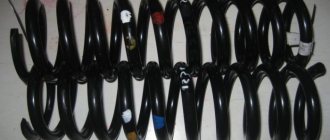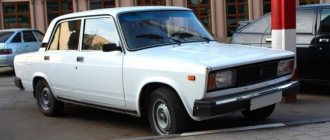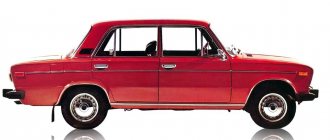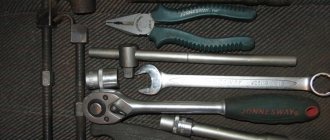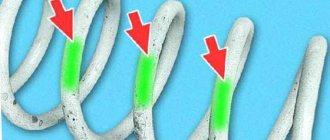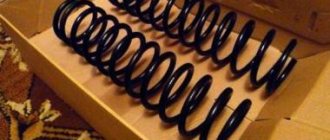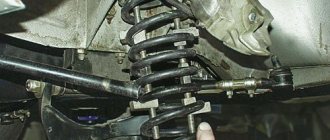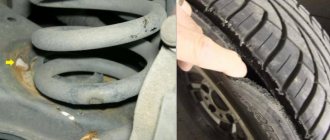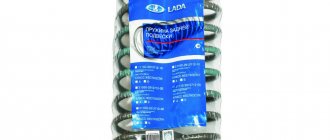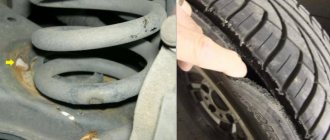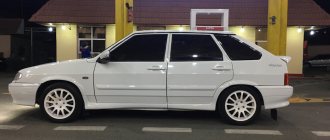Main varieties
Before we begin to consider the types of springs for cars, let’s briefly remember why they are needed.
When moving over uneven surfaces, the car should remain soft. Otherwise, the trip will be no different from traveling by cart. To ensure comfort, automakers equip vehicles with suspension. In fact, comfort when using the suspension is an added bonus. The primary purpose of springs in a car is transport safety. When a wheel hits an obstacle at speed, such as a bump, the shock absorber softens the impact. However, to prevent the car from losing traction with the road surface, the wheel must be quickly returned to a hard surface.
Types of springs
The most common are 4 categories of car springs. They are most often installed on vehicles. At the same time, the products are somewhat different from each other, having certain characteristics and advantages.
There are 4 categories of auto springs:
- Standard. This is a basic or standard version, which is mainly installed on passenger cars from the factory. Most modern models adapted to normal operating conditions are suitable;
- Reinforced. Helps improve vehicle performance. An up-to-date solution for those for whom it is important to obtain additional strength and stability on the rear and front suspension elements for off-road driving, transporting a heavy trailer or cargo in the car itself;
- Raising. Or overpriced. Their installation makes it possible to increase the ground clearance, that is, ground clearance, and also improve the load capacity;
- Lowering. They are also called underestimators. An option for fans of sports driving. They serve to specifically reduce ground clearance and shift the center of gravity of the car.
All categories of springs are in demand and widespread in sale and use. Which ones are right for you, proceed from the operating conditions and the tasks you set for your machine.
Replacing springs may be necessary on almost any car. It's more a matter of wear and tear. If you are not going to change the operating conditions, standard products are replaced with exactly the same ones.
The procedure for replacing springs is carried out on different cars, including:
- Volkswagen Golf;
- Chevrolet Lanos;
- Renault Traffic;
- Peugeot 308;
- BMW X5;
- Skoda Octavia;
- VAZ 2110;
- VAG cars;
- Audi A8;
- Audi 100;
- Toyota Avensis;
- Mercedes ML;
- Lada Priora, etc.
The make and model do not make a fundamental difference here, since the springs can fail on any car.
But when purchasing new products, the specific brand, model, generation and a number of additional parameters must be taken into account. This allows you to select the parts that match your vehicle as accurately as possible.
Trailer for transporting an ATV: reviews, do-it-yourself modifications
In addition to color, an important indicator of an autospring is the diameter of the structure. It is determined not by the manufacturer himself, but by the car company that designs the car model. The executor of orders for the release of springs cannot independently make any changes. All parameters are calculated and verified in advance. This will allow the car to further meet the automaker’s promises in terms of comfort, safety, ground clearance and other indicators to which springs are directly related.
The abundance of flowers should not confuse motorists. This is especially true for owners of VAZ products. In this case, class A includes white, yellow, orange and brown marks. If the mark is black, blue or cyan, then it is class B.
I briefly explained the essence of the marks. The values of the marks in kilograms and millimeters during compression and stretching, as well as their combinations for different cars may differ from each other. Here you need to specifically look at the specifications for your car. Unfortunately, you can’t tell about all the cars in one article. But in general it should be clear.
Coil springs are:
- Cylindrical.
- Conical.
Springs wound on the form can have not only a regular cylindrical shape, but also a conical one. In it, each new round is already smaller than the previous one. Such a product is used if it additionally has a supporting function. It not only responds to deformation, but also acts as a support. Conical springs can be found on classic road bikes where they support the seat.
Coil and conical springs can be conventional or compound. Compounds are double. These are 2 springs of different diameters connected together. One is located outside, and the second is placed between its turns. Thus, they work together to provide the required level of rigidity.
Understating what it looks like on your car
I was surfing the Internet, looking for lowering springs, and it was KLAXON that I found interesting information. After all, when there is a desire to lower a car, a lot of questions arise - how much to cut the springs - cut the stock or put it with a lowering - what the end result will look like Below, I will give some examples of lowering, which may help and solve some of your questions
1 Wheel stock springs 14′
2 Stock springs front - 2 turns rear - 2 turns wheels 14′
3 Stock springs front - 2 turns rear - 3.5 turns wheels 13′
4 Klaxon springs yellow - 50 wheels 14′
5 Klaxon springs yellow - 50 rear - 0.5 turns
6 Klaxon springs yellow - 50 front - 1 turn rear 1.5 turns wheels 15′
7 Klaxon springs yellow - 50 front - 2 turns rear - 5 turns wheels 15′
8 Klaxon springs red - 30 wheels 14′
9 Klaxon springs green - 70 wheels 13′
10 Klaxon springs green - 70 front - 1 turn rear - 2 turns wheels 15′
11 Klaxon springs green - 70 front - 1.5 turns rear - 3 turns 16′ wheels
12 Klaxon springs blue - 90 wheels 14′
13 Klaxon springs blue - 90 rear - 1 turn of wheel 15′
14 Klaxon springs blue - 90 - 2 turns in front of 15′ wheels
15 Phobos springs - 40 wheels 13′
16 Phobos springs – 40 front – 1 coil rear – 1 coil 15′ wheels
17 Phobos springs - 40 front - 2 turns rear - 3 turns wheels 15′
18 Phobos springs - 40 front - 2.5 turns rear - 4.5 turns 15′ wheels
Source
Choice depending on manufacturer
When choosing new springs to replace worn-out springs, many motorists often opt for original spare parts. However, similar products can be found in the assortment of other manufacturers, which have good reviews from those who have already used a similar product.
Here is a small list of the most famous manufacturers of quality springs:
- Sirius is a domestic company whose product range includes a large selection of products for different car models. All products sold correspond to the drawings provided by the customer.
- Phobos is another well-known manufacturer that offers a large selection of not only standard springs, but also backlash complexes that allow you to change the vehicle’s ground clearance depending on need. True, reviews from many users are not in favor of the manufacturer. The reason for this is the short service life of the products, regardless of the stiffness of the springs.
- "Tehnoressor" - the company offers budget products. Over time, these springs lose their stiffness, but do not sag. The brand mainly produces standard elements for pendants.
- The list of European manufacturers is opened by Koni. The Dutch manufacturer produces high-quality elements for suspensions of any vehicle, regardless of whether it is a Japanese or domestic car. The peculiarity of this product is that many parts have manual adjustment of rigidity. The driver himself can set the desired ground clearance by moving the thumbwheel to the appropriate position on the rack.
- Another European manufacturer is the German company Eibach, whose product range includes a wide variety of various parts for suspensions and chassis of cars. It is worth considering that the products of this company are very expensive, but the quality of the products compensates for the waste. Springs rarely burst, do not lose their rigidity for a long time, and do not sag.
- The SS20 company was founded in 1993, and today it provides a large selection of suspension spare parts for any domestic vehicle, as well as for many foreign cars. According to the manufacturer, the stiffness of each spring is checked on a special stand, based on which a pair is selected for the product. Thanks to this, the purchased set will consist of identical springs. In addition to a model of a specific class, the car owner can choose a product that differs in manufacturing technology.
- Kilen is an excellent replacement for standard VAZ springs. According to the manufacturer, the original spare part costs half as much as the products they offer.
- The springs have excellent resistance to heavy loads. For this purpose, special metal alloys are used, which after certain processing do not burst, and also do not sag over the years. To extend the service life of products, the manufacturer coats the springs with a special material that includes epoxy resin.
In addition to the above, we offer a short video on how to determine that the springs need to be replaced:
Lowering the suspension (all stages of evolution):)
Greetings friends and readers!
(I immediately apologize for the rare updates in the bulletin board. There’s a lot to do, there’s not enough time to sit and write a blog)
As many owners of Priorics (and, in principle, any TAZ, as well as many foreign cars) know that tuning begins with the suspension :) Well why not, I literally “dropped” my car by 5 cm and it began to look different. The length and width of the body visually becomes larger, you begin to stand out among twin cars, you begin to catch glances on the streets (although many of these glances regard you as a fool, that’s how it started with us):), etc.
The most important thing is that your iron friend changes in character, regarding control on the road, but for this you need a competent approach to suspension tuning (well, those who understand, will understand):)
I won’t talk about the origins of Lowriders in California, the Stens, BPAN trends... many have already heard about this, at least half an ear :)
I’ll tell you better about how I got confused, what mistakes were made and how I finally found my “ideal” :)
The first urge “to go to this very thing” appeared at the stage when I just saw an advertisement for the sale of my Princess :). I immediately had a condition for myself that if I buy a Lada, I will definitely lower it :)
As a result, I bought it and installed the first “config” of the suspension after 2 weeks of ownership. All these thoughts were stimulated by the appearance of the car, too raised, now I’m going to go to the garden :), as well as the work of the factory suspension. It is neither comfortable nor rigid, the controls are weak, it rolls. In general, no one needs to tell anyone about the stock suspension, everyone has driven it, everyone knows. Previously, and I think now, for comfort, everyone immediately changes the struts without the goal of lowering, but for comfort (as far as I remember, a long time ago many people installed Monroe on Nines):)
In addition to my being spoiled by a busy automotive life, there was a point that I did a lot, both for myself and as a hobby, in various tuning of Germans, British, Americans, etc., but RusAuto did not understand which brands, etc.) )
After Googling, asking around and reading the Drivers' BZ, I realized that there are normal brands.
I settled on Technoressor springs, but still took Demfi struts (although FOX was in the plans, but they couldn’t deliver it). The price is quite adequate, especially for young people driving Russian cars :)
Well, now we begin to list the stages, and there will be THREE of them!
Based on components:
The bump stops were not cut. They did not fasten the springs; many on the forums wrote that they would not go anywhere (barrels).
Result:
Traveled for 1.5 months. Visually, I very quickly got used to the appearance, or rather, 5cm was not immediately satisfactory (not enough). At first the car became stiffer, and this actually made me happy. After 2 weeks the car became a rattle because it was necessary to cut the bump stops, and the old stock struts seemed to have stopped working.
So I moved on to the next stage...
What was installed:
Dampers for Demfi (I think SS20, I don’t remember exactly)
I wanted to buy complete SS-20 supports, but they convinced me that everything would be fine on the stock supports if they were intact.
Eventually
collected and I left the box. Amazing! After what I drove before, there were no complaints. Many people say that gas oil always produces a gear crusher - NO. The car is definitely tougher than stock, but not a go-kart. The suspension works as it should, and most importantly, all other elements of the chassis also work correctly, because that’s what the struts are designed for :) The car began to feel more confident when cornering, and especially on clovers.
But in the end, the “Wishlist” won and today I have this “spec suspension” installed...
At the same time, I replaced the steering tips and support bearings (the old ones fell apart).
As a result, what we have for today: Quite satisfying appearance, excellent handling and comfortable suspension, both for every day and for gripping on the roundabout :)
The calculations inside my head did not disappoint, the suspension travel actually became longer, I won’t say much, but enough so that after passing a recumbent, the car did not jump, but squatted a little. The suspension works great, doesn’t crunch anything, and doesn’t break through on bumps. I hung the wheels, the spring sits like original.
In terms of ground clearance, which worries most motorists today, it has become approximately 100mm lower than the standard, but for me personally this is enough, I can drive everywhere, I even calmly go to my granny’s garden :) and I can easily drive into my underground parking lot, where Priorka lives ...yes, as they say, there were even lower cars :)
I would like to say at the end,
Don't be afraid to experiment. In the end, you will always achieve what you want.
And don’t really pay attention to all kinds of “teachers”; tuning and lowering the Taz is nonsense, because it won’t fly into space, it will just be a bucket...
Well, yes, it’s possible, but it will be a “bucket” that lives with you and you get a kick out of how she is when you go to see her, when you drive... and when you’re at work you can open the gallery on your phone and see her photos and your mood will begin to rise.
This is where we are, people in love with cars/motorcycles. This is our meaning to achieve something more!
Springs are classified into the following types according to their impact:
- Bend.
- Torsion.
- Stretching.
- Squeezing.
Flexion springs resist the force directed at their bending. This quality is used to press machine parts together. An example is disc springs.
Torsions are equipped with elongated, smooth edges of hooks, which are fixed in the mechanisms. If you try to change their normal position in any direction, they return back due to the elasticity of the coiling of the main body. An example of such elements are torsion springs in clothespins.
Compression and tension have a similar structure and differ only in the size of the gap between the turns of the winding. The compression element reacts when subjected to pressure. This is the type of spring used in pressure keys.
Why is color coding required?
The mark placed on the product will help the motorist select a modification that meets his needs. If you install springs of different stiffnesses on a car, the body will not be parallel to the road. In addition to the unaesthetic appearance, this is fraught with instability during driving - one part of the car will be depreciated in a mode different from the other side of the vehicle.
The same applies to the height of the products. In this case, of course, the size of the parts is often compared. To speed up the process of sorting products, manufacturers apply a color mark to all products that corresponds to specific technical characteristics.
What does the marking say?
If you take a car spring, you will notice that different products may have different colors with which they are marked.
All marks are often colored. The following shades are used:
Moreover, the last two colors are found mainly not as a method of marking, but simply as the color basis of the product itself.
Differences in color make it possible to determine the degree of hardness relevant for a particular sample as simply and clearly as possible. Special tests are carried out at factories. The springs are compressed with a regulated force and the height is measured. If a part does not meet the specified parameters, it is rejected.
All designs that have successfully passed tests receive class A or B. Class A is relevant for springs that fall within the upper tolerance range, that is, hard ones, and class B for softer ones. The height of the latter corresponds to the lower tolerance zone.
What is the spring made of?
For the production of springs, specialized wire with increased elasticity parameters is used. All types of springs are made from it, except disc springs. The latter are manufactured by stamping on sheet steel.
Spring wire is produced by rolling from a specific steel alloy. Thanks to the specialized composition, after heat treatment, the finished product does not break under mechanical stress within the limits of design loads. It also acquires increased resistance to loss of elasticity after repeated deformation.
Usage and differences
The springs come in a variety of colors to help the driver select the correct replacement spring. It is allowed to install springs of both classes A and B on the car, but the colors must be identical. If this rule is violated, the body will tilt to one side.
You cannot install springs of different classes on a car. In this case, class A springs can be installed on the front axle, and class B springs on the rear axle. Any other order is unacceptable. Color and grade must be the same.
It is believed that class A springs are stiffer than class B springs, regardless of color. This is only partly true. Class "A" is ideal for vehicles with a larger load. It should be noted that there are spring samples without mandatory markings. Such elements are not worth purchasing, much less using.
Only springs of proper quality should be installed; they will ensure a soft ride, little wear and tear on the vehicle and an average load on the driver.
Installation Tips
- Is it possible to install parts of different classes?
Remember that the springs on the suspension must be of the same class.
Let’s say you installed A-class parts on the front suspension, which means you also need to install “A” class on the rear suspension. If a similar class is not available for the rear suspension, then in exceptional cases class “B” is assigned to the rear suspension.
If B-class springs are installed on the front suspension, then class “A” springs cannot be installed on the rear suspension.
Install suspensions of the same class on the left and right sides of the same axle.
- What springs are better to install on a VAZ 2107?
Before changing parts, make sure that it is really necessary. You can check it in the following way: standing at the front of the VAZ 2107, swing the body down. If it quickly rises to its original position, there is no need to replace the springs; they are in good condition. If the body does not rise and continues to sway, then replacement is necessary. In the same way you can check the rear suspension of the VAZ 2107.
To improve the aerodynamics of the VAZ 2107 and improve the sensitivity of the steering wheel, it is recommended to install stiffer springs than the original ones. You can buy those designed for VAZ 2104, cut off one turn. It is imperative that on a VAZ 2107 you need to change two at the same time, otherwise the car will lose stability on the roads.
It is not recommended to install reinforced rubber gaskets on 2107, because the spring will break through.
- Will Niva springs fit on a VAZ 2107?
If you want to make a sports tuning on the VAZ-2107, the suspension is made more rigid, this improves the quality of handling without reducing the level of comfort.
The rear springs are stiffer than the front ones. The factory ones are too soft, and the car quickly loses control, the bottom gets scratched on the road surface. To increase the stiffness of the suspension, it is recommended to install Niva springs on the VAZ 2107.
- What springs are better to install on a VAZ 2110?
On the VAZ 2110, the front spring often breaks due to poor quality roads, so it needs to be replaced. Moreover, you can do this yourself, without contacting a car service. All that remains is to find out what is best to choose from the range offered for the 2110.
On the front suspension of the VAZ-2110, as standard, 2108 springs are installed, on the rear suspension - 2110. In the absence of original parts, car enthusiasts are advised to install SS20 highway, the car rides smoothly and is stable when cornering.
- What springs are best to put on a Priora?
If the springs on the Priora have sagged, it is recommended to install new original ones from VAZ. Choose only the class depending on the goals of your tuning. Class "A" is more stringent. In the absence of the original one, according to car enthusiasts, it is better to install a kit with a lowering Eibach Pro-Kit (-30 mm).
- What springs are better to install on a VAZ 2114?
The VAZ 2114 suspension is quite durable, and the need to replace parts occurs quite rarely. Therefore, not all car owners of 2114 cars know what is best to choose from the wide range offered on the markets.
Sometimes springs from 2112 are installed on a VAZ 2114, they are a little stiffer, designed for a larger weight of the car, so they raise the 2112 slightly - by 2-3 cm, which means that in this way you can increase cross-country ability. If, on the contrary, there is a desire to lower the car, then it is recommended to purchase an Eibach, with the front ones being -5 and the rear ones -7, so that the car does not ride up.
So, the choice of springs for VAZ is quite wide, the main thing is to choose the correct stiffness characteristics according to the load on the car and operating conditions. You will find a variety of advice on forums and blogs. Of course, it is better to first consult with specialists. Refusal of original parts in favor of other manufacturers may be dictated by the desire to improve the driving performance of the car, but be sure to compare the cost of tuning and the result obtained.
How to make a spring at home
In almost every mechanism where a spring is used, it has its own parameters of diameter and height. As a result, after it wears out, it becomes difficult to replace. For fairly modern mechanisms, springs can be ordered from a spare parts supplier, but for old ones that have already been discontinued, this is not possible.
In this case, you can make the spring yourself. To produce it at home, you need spring wire. Since it is often sold in weights of 1 kg or more, this is too much to produce one spring. In this case, you can purchase any spring made from wire of the required diameter at a hardware or auto store.
Using it as a source of material, you can manufacture a product with the required parameters by repeating the factory technology in a simplified version. When heat treating springs in production, their heating and cooling is done with precise temperature control by measuring equipment.
Fun on the beach
Despite its remoteness from the bustling center of Sochi, Lazurny Beach, thanks to the purity of the water and a wide variety of attractions, attracts many visitors not only from Lazarevsky, but even from Sochi. The entertainment infrastructure of the Central Lazarevsky Beach includes:
- Jet skis;
- Catamarans;
- Yachting;
- Parasailing;
- Boat trips on motor ships;
- Children's attractions on the shore;
- Basketball and volleyball courts.
At the height of the holiday season, entertainment events for vacationers are often held near the shore in the evening, in particular, beach discos.
Froll Fomich
Classification of suspension springs by color
To choose the right spring for your car, the motorist must pay attention not only to the markings in the form of colored stripes applied to the outer side of the coils. An important factor is also the color of the spring itself.
Some people think that the coloring of these parts serves only a protective function (the paint is actually applied to prevent the formation of metal corrosion). In fact, first of all, this is done so that neither the motorist nor the auto parts seller makes a mistake in choosing a part.
Thus, the color of the spring body indicates the model of the car, as well as the installation location - rear or front element. Typically, the front spring for VAZ family cars is painted black, and the coils are marked accordingly, which will indicate the degree of stiffness.
There are also blue modifications with variable interturn spacing. For classics, such parts can be placed on the front part of the suspension.
Here is a small table of what color a specific spring will be designated for some VAZ models. Class A indicated in the table is a hard characteristic, and class B is a soft one. The first part is marking the stiffness of the front elements:
| Automobile model: | Spring body color | “A” class marking: | Marking "B" class: |
| 2101 | black | green | yellow |
| 2101 variable pitch | Metallic blue | green | yellow |
| 2108 | black | green | yellow |
| 2110 | black | green | yellow |
| 2108 variable pitch | Metallic blue | green | yellow |
| 2121 | black | not marked | white |
| 1111 | black | green | white |
| 2112 | black | not marked | white |
| 2123 | black | not marked | white |
The second part presents the rear spring stiffness markings:
| Automobile model: | Spring coils: | "A" class markers: | Markers "B" class: |
| 2101 | white | green | yellow |
| 2101 variable pitch | Metallic blue | green | yellow |
| 2102 | white | blue | red |
| 2102 variable pitch | Metallic blue | green | yellow |
| 2108 | white | green | yellow |
| 2108 variable pitch | Metallic blue | green | yellow |
| 21099 | white | blue | red |
| 2121 | white | black | not marked |
| 2121 variable pitch | Metallic blue | green | yellow |
| 2110 | white | black | not marked |
| 2110 variable pitch | Metallic blue | green | yellow |
| 2123 | white | black | not marked |
| 2111 | white | blue | orange |
| 1111 | white | green | not marked |
A little about choice
I would like to note that different shades are used, and therefore some colors mislead consumers. The same orange or brown markings often look like red, but yellow ones turn out to be orange.
As for how to choose a product and determine the desired hardness by color, then you should look at the strip on the outside of the coil. It is there that a trace of paint is applied and it allows you to determine the desired characteristic.
The color of the springs themselves can be different. It largely depends on the protective coatings used. These are mainly chlorinated rubber and epoxy enamels. Decoding should be done not by the color of the product, but by the color of the special indicator mark
It doesn’t matter whether it’s a VAZ or a VW car
Although the color of the protective coating is also important. It often serves to determine the car model for which a particular car spring is intended. Plus determines where the element is mounted - in front or on the rear suspension.
Subscribe, leave reviews and invite your friends to join us!
(8 ratings, average: 3.13 out of 5)
Topic closed. If you still need help, sign up for our car service for diagnostics and repair of a Mercedes by calling: (495) 381-21-87,.
Ask your question in a separate topic
Buy the original MV, there will be one option; DAS cannot issue three options according to the VIN code, it won’t happen that way. Change seller.
Unfortunately it is so. It's the fault of the program that gives these three markings. from different sellers.
What program? DAS is a dealer program for spare parts, there cannot be more options than one, give me the VIN code of your car.
WDB2030451F176178 I would be very grateful. I don’t know where to look for DAS in our city, we looked at exist and somewhere else. There is no dealer office in the city either.
PS only a Japanese gelding, therefore the suspension looks softer. I would like to be tougher than my native Japanese
On Monday I will give an answer, I will only give what should have been there from the factory, the original and not the original, the stiffness will remain as from the factory, if you want from AVANTGARDE, you will have to change the shock absorbers, since the spring is shorter and the shock absorber stroke is different.
I will be very grateful, I’ll install it like it came from the factory. I'll stick the shock absorbers harder and I think I'll like it.
Your car was made for Japan, the original German program cannot normally open the VIN of your car, and also shows as many as 7 options for springs, in such cases you need to crawl under the car or lift it and tell what color the dots on the spring are and how many there are.
When you open a German wine, only one option is always displayed, namely the one on the car.
We don’t have such cars in Germany, and MV has its own nuances for each market
That's what I was talking about, several options. As for crawling under the car, I did that first :)))) there’s not a single mark, I washed both springs and climbed with a flashlight for half an hour. Absolutely clean black springs. That’s why I’m in such a stupid dead end. Exist gives three options: 1x-grey. 2x-grey. 3x-grey. I would at least like to know what this means.
Original spring number: A2023241804 (2 grey, 175 points)
Not original from LESJOFORS - 4256850.
The original costs 69 euros, not the original 30 euros.
oh you're so huge. Can you find out what 175 points are and how 2 gray differs from 3 gray?
175 points is a height measurement for MV, 2 gray differs from 3 gray in hardness, but I don’t know which one is harder and which one is softer.
Damn, what a shame, I want it harder.
Sorry, no one here is involved in such pseudo tuning, if someone really wants it, then all 4 shock absorbers are installed and all 4 springs are installed under them, and if you change only the springs, then they can either burst from stiffness or the car will fall.
Manufacturing Features
Most machine parts are manufactured using a specific technology, so they comply with standards. However, in the case of spring production there is a slight subtlety. The manufacturing process of a part can involve operations that are often difficult to control.
For this reason, companies involved in the mass production of car springs cannot create identical parts. After leaving the assembly line, each spare part from this category is tested for rigidity. After comparing with the standard, specialists apply special marks to the products. Marking allows you to classify each product into groups, which are mentioned a little higher.
Differences between springs depending on their markings
If the paint designation indicates the rigidity of the part, and this parameter may vary depending on what raw materials the manufacturer uses, then the diameter of the threads must exactly correspond to the requirements of the automaker. Everything else remains at the discretion of the company fulfilling the order for the production of these products.
At the factory they can:
- Use blanks of different diameters. Automakers also allow the creation of springs with varying diameters within acceptable limits. For example, the initial turns may be thinner than the main turns.
- Change the height of the springs, as well as create parts that are identical in size, but have a different stiffness parameter.
- Change the number of turns and the distance between them, while taking into account the outer diameter required by the automaker. Regardless of the interturn distance, the element can be either soft or hard.
A simple procedure helps determine the conformity of the finished product to the manufacturer. The spring is compressed with a specific force and the height is measured in this state. If the product does not fit within the framework established by the car manufacturer, the part is considered defective.
Based on such control, suitable products are also divided into two classes - A and B. The first class is products whose length, when compressed with a certain force, is maximum (within the limits of the manufacturer's data for specific cars). The second class corresponds to the lower limit of the same parameter.
All products that fall into a specific class receive their own designation. Paint is used for this. For models of the VAZ family, the class A color marker will be represented in yellow, orange, white and brown.
However, the same classic can also be equipped with springs included in the second category. In this case, they will be distinguished by green, black, blue and blue.
Labeling and classification
Color marking can solve the problem of choice for car enthusiasts, but at the same time it is the result of a complex process. It is difficult to control each stage. For this reason, finished products are analyzed. This is how a method of classification by color appeared. In this way, you can distinguish the elements from each other. There are other options, but this method is simple and reliable.
Springs also differ in parameters. It is determined by the car developer and cannot be changed during production. But it depends on the manufacturer:
- diameter of the spring rod;
- degree of hardness.
These elements differ in color; the degree of hardness cannot be determined in any other way. They are painted in a varied color palette, but the hardness parameter is not difficult to determine.
Two classes are suitable for VAZ cars; they are painted in the following colors:
- Class A is marked white, yellow, orange or brown.
- Class B - black, blue, light blue and yellow.
To find out what the stiffness of a certain spring is, you should look at the strip, it is located on the outside of the coil. However, the color may be different. The color of the spring depends on the protective coating. It will save you from destruction. Epoxy or chlorinated rubber enamel is usually used. You can understand the markings of springs solely by the color of the strip on the coils.
The color of the surface depends on the car model, as well as the place where the spring is installed - in the front or rear. The front elements are coated in black.
Based on their design, springs are classified into several types:
- Screw.
- Torsion bars.
- Spiral.
- Disc-shaped.
- Wave.
Screw ones are the most widespread. They are tube shaped. The element is obtained by winding a wire or rod onto a cylindrical template. After which the workpiece can be hardened and tempered. Depending on the winding method, the direction of operation of the spring depends.
The presence of gaps between the turns allows it to be used as a compression element. An example is springs in ballpoint pens, car suspensions, and motor vehicles. When tightly wound, the spring is triggered by tension. Such elements have hooks on the edges of the eyelets. They are used in automatic door closing mechanisms.
Torsion bars have a similar design to screw bars. However, they are designed to respond to torsion and bending. The ends of such springs are made elongated for hooking during installation. When exposed to torsion, the element resists. Torsion springs, for example, are used in complex door closing mechanisms.
Spiral ones have the shape of a ribbon twisted into a spiral. This element is used to store energy. When installed in the mechanism, it twists, accumulating energy for unwinding due to its elasticity. These are the springs that are used in watch movements that operate in factories without the use of an electrical power source. They are also used in manual starters for chainsaws, lawn mowers for returning the cord back, etc.
A disc spring looks like a washer curved into a cone. Due to the elasticity of the metal, it resists compression. They constantly support nuts or other components. This is a rather rarely used element, but it is widely used in the steering rack mechanisms of most cars.
Wave ones are a tape laid in a sinusoid, that is, a wave. It is wound in a circle, like screw products. However, thanks to the wave-like laying during compression, it acts back equally across the entire plane without tending to move to the side.
Headrest with monitor: comfortable travel for rear passengers
The production of springs for cars involves various technologically complex operations. Not all of them can be controlled. Some of them are even impossible to follow directly until the result is obtained in the form of a finished spring for a vehicle suspension.
Thus, a classification by color arose. This is one of the few ways to distinguish elements of different stiffness indicators after their manufacture has been completed. Yes, there are alternative methods, but color is considered the most simple, reliable and informative.
How are springs marked, what does the color of springs on VAZ cars mean?
Suspension springs perform several important functions. In addition to having a significant impact on the handling and load-carrying capacity of the vehicle, they also smooth out uneven road surfaces and increase comfort while driving. However, it is very important that springs of the same class are used in the chassis. To avoid mistakes when installing them, manufacturers must mark the springs.
- Classification
- Manufacturing Features
- Differences between suspension springs and their markings
- Important
- Interesting
The operating spring stiffness depends on a number of parameters:
- Chemical composition of the metal.
- Heat treatment method.
- Diameter of the wire used.
- Number of turns.
- Turning frequencies.
One of the most important parameters when choosing a spring is its stiffness coefficient. It determines how much force is required to compress or stretch the finished product. This parameter is a consequence of complex engineering calculations that take into account many indicators of the mechanism in which the spring must be installed.
If the spring matches the mechanism in length and diameter, but it requires significantly more force than required to deform it, then the system will not be able to work. In essence, the developed clamping force is not capable of causing an elastic response. If, on the contrary, the stiffness of the spring is not enough, then, having stretched under load, it will not return back. A similar situation will occur during compression.
The stiffness of all types of springs depends on temperature. When selecting them, it is optimal to assess the hardness at the temperature at which it will be used. The warmer it is, up to a certain threshold of metal stability, the higher the elasticity. When cooled, the structure of the metal changes, and the springs acquire less travel and increased fragility.
Reducing the clearance on a VAZ
In the case of lowering the suspension of a VAZ “classic”, a special approach to work is required. Simply cutting off the springs is not the best option, because after just a few tens of kilometers the car can become severely distorted. And it’s not far from breaking the shock absorber and the spring itself.
The best option is to install low springs. But at the same time, it is advisable to select suitable shock absorbers.
For example, if you plan to reduce the ground clearance by 40-50 mm, then it is worth buying shock absorbers that can work in such conditions. It is strictly forbidden to lose sight of this moment.
On VAZ cars, the ride height can be adjusted in the range from 20 to 90 mm. Anything more than nine centimeters is already dangerous. And it is almost impossible to implement this in practice.
To make the suspension durable, it is necessary to install new boots and rebound buffers during installation. But that's not all.
It would be a good idea to replace the support bearings on the front struts (this will significantly reduce the force on the steering wheel).
Properties of suspension springs
For car springs, there is such a thing as fatigue, and they sag. This means that the distance between turns becomes smaller over time. Because of this, part of the car begins to sag. In such cases, the part must be replaced.
If the springs are not replaced, this may have the following consequences:
- When the rear part sag, the carrying capacity of the vehicle is reduced, and on large bumps the soft suspension will not protect against impact, for example, with a muffler on the ground;
- On the same bumps, the wheels will begin to rub against the wheel arch protection;
- The shock absorber will wear out faster, and if it subsides too much, the part may break through, since the piston will often collide with the base of the liner with oil;
- Failure of the shock absorber will also negatively affect the body elements - most often in this case the fastening suffers;
- Old springs may have a coil that breaks, causing the car to lose control.
Depending on the operating conditions, car springs can be maintained for five to ten years, but if you constantly drive over potholes, these parts may require replacement even earlier. There are cases when such elements have not been looked after for even three years.
In addition to natural compression loads, pebbles can fly out from under the wheel while driving on the road. When they hit the spring, they can cause paint chips. Exposed metal will be subject to an oxidation reaction, which will also reduce the life of the part.
Previously, torsion bars were used as dampers on cars. Thanks to the use of springs, vehicles have become more comfortable and their handling has improved.
To choose the right springs for your car, you need to pay attention to the following factors:
- The thicker the rod from which the spring is made, the stiffer the product will be;
- The stiffness parameter also depends on the number of turns - the more there are, the softer the suspension;
- Not every spring shape is suitable for a particular vehicle. Non-compliance with the parameters specified by the vehicle manufacturer can lead to discomfort (for example, while driving, a large spring will rub against the fender liner), and sometimes even worsen handling.
Don't buy the stiffest springs. They improve steering response, but reduce traction. On the other hand, softer analogues will create a lot of inconvenience for country roads. For these reasons, first of all, you need to start from which roads the car is driven on most often.
Spring classes “A”, “B” and “C”, which ones are better
Spring Rate Suspension
springs not only improve handling quality, but also ensure a smooth ride on rough roads. In addition to their useful qualities, they have a number of characteristics; their compliance with the requirements of the car is extremely necessary. Data such as length, thickness, shape or even the material of pendants play an important role, and neglecting the choice will lead to dire consequences.
Let's look at the classes of suspensions. It is generally accepted that the more expensive the components of the mechanism, the better. And this topic could be discussed for a long time if the matter did not concern springs, which, like cars, are divided into three categories “A”, “B” and “C”.
The first class includes products of world famous brands. These are premium elements from companies such as Sachs, Kayaba or Bilstein. When you look at these brands, you can see that their reliability matches your budget. An ordinary driver cannot count on affordable prices. However, these companies provide full guarantees of longevity and strength.
Subtype “B” is responsible for cheaper suspensions that are accessible to the average consumer. Do not rush to be upset if you cannot afford the elite among manufacturers, because middle class parts are of acceptable quality.
And finally, cheap “C” class goods, which cannot be characterized by high quality, are nevertheless the most affordable for the entire segment of motorists. What's the trick and why is it so budget-friendly? The fact is that companies selling springs in this category massively purchase ready-made suspension elements from a Chinese manufacturer.
How to choose the right part? We dealt with different classes, made certain conclusions, but how do you still choose chassis springs for your car? Among the large assortment, choose exactly those designs that most closely resemble the original ones. You need to choose a product with an ideal seat and original outer diameter. In this case, the number of turns in the spring and its length are not particularly important
Please note that color markers and bar diameter measurements differ from one manufacturer to another, so when choosing, focus on the manufacturer, the type of mechanism and its rigidity. Choosing the wrong product may impair vehicle stability and damage the body and shock absorbers.
Bottom line. If you have several parts of different classes, remember that the best springs must be installed on the front axle. It is impossible to assemble and combine parts on both sides of one axis, and if one of a pair of products fails, both should be replaced. Always listen to the advice of the manufacturer of your car; no one else recommends a more correct approach in choosing a chassis. Incorrectly selected springs will change the ground clearance and shake the angles of the wheel configuration, which is why all other elements of the vehicle will wear out extremely quickly.
Ax against roundness. Test drive Jeep Wrangler Sahara
See all photo news >>
Correspondence of spring markings to the model
Let's look at what springs need to be used in specific models of the VAZ automaker:
- Springs 2101 are intended only for “penny”;
- A more rigid modification is marked 21012. They are made from thicker rods, which makes the products stronger than the previous analogue. They are installed on classics, which require a more energy-intensive suspension;
- Springs with symbols 2102 are intended for station wagons models 2102 and 21014. Compared to previous modifications, these parts are two centimeters longer. They can be installed on a sedan, but only if the car is used in rural areas. Such springs slightly increase the vehicle's ground clearance. However, they cannot be installed to enable the vehicle to carry heavier loads than those intended by the manufacturer. Otherwise, the body will have to be repaired very soon.
- The designation 2108 is given to parts intended for front-wheel drive VAZ cars. The exception is Oka and models with a 16-valve engine. It is worth considering that these same springs are also intended for 21099. There are no separate springs for this model, so the seller’s offer to purchase “originals” for the 99th is nothing more than an attempt to sell standard parts at a higher cost.
- Elements from European manufacturers marked 2110 are intended for models starting with 21102 and ending with 21104, as well as for VAZ-2112 and 2114. The European version makes the car 2 centimeters lower, but makes it more controllable at high speeds. You should not use such parts on vehicles that often travel on dirt roads and rough terrain.
- Modifications 2111 are intended for rear suspensions of models with identical markings, as well as VAZ-2113.
- Springs from category 2112 are intended for the front part of the suspension of the following models: 21113, 21103 and 2112.
- All-wheel drive vehicles of the VAZ family are equipped with 2121 springs.
Selecting products by labeling
So, the driver came to the store to buy new springs. How to make the right choice?
The decoding of the markings shown below can help with this:
2101 - perfectly fits standard sedans equipped with rear-wheel drive; 21012 - rigid springs, which are mainly used on special vehicles; 2102 - originally created for Russian station wagons
When installing this product, the vehicle's ground clearance increases, which is quite important if the vehicle is operated off-road; 2018 - usually installed on any vehicle with front-wheel drive, except for Oka and those cars that have a 16-valve power unit under the hood; 2110 - these products were created for expert Russian models from VAZ; 2111 - work on models such as VAZ 2111 and 2113. Only on rear-type suspensions; 2112 - analogue of 2111, only for front-type suspension; 2121 - most often installed only on all-wheel drive vehicles. First of all, this is a simple Niva.
First of all, this is a simple Niva.
New springs for VAZ
The markings are easy to understand. But it is still necessary to understand how the manufacturer influences the choice of springs.
